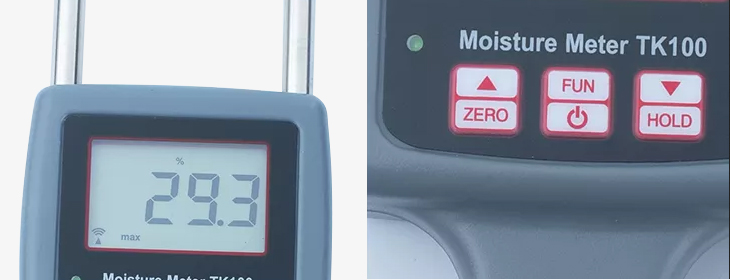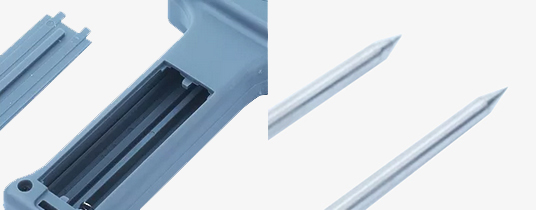sisco multifunctional moisture tester allows you to determine when the grain is dry for use. Buy a digital moisture meter with a 0-80% measure range, 2 pins, and a digital display with a back, the moisture content of wood, grains, fiber, and bran can be measured.
Features
- Digital multifunctional moisture tester has a wide measuring range of moisture, high precision, clear display, rapid measurement, stable performance, small size, and can be carried in the field for rapid detection and easy to use.
- It is a good handheld moisture meter for testing the moisture content of products in food, agriculture and other industries.
- The time of moisture measurement is shortened, the whole process is operated for less than a minute, and the measured value is displayed in real-time.

LCD display/Operation area
- Multifunctional moisture meter with a backlight LCD technology clear display, and low power consumption.
- Microprocessor control, multifunctional moisture tester built-in program automatic protection measures, good stability.

Probe type sensor/Power Supply
- Wide working range, probe type sensor can be used for in-depth measurement of materials.
- The power supply of the multifunctional detector is equipped with 4 No.7 batteries.
Applications
The moisture meter, also known as the moisture detector, is an instrument that can quickly measure the moisture content. It is used for the moisture control of raw materials, production process, laboratory final quality control and other links in various industries such as food, chemical, plastic, agriculture and forestry.

- Model: SISCO-MM-TK100
- Display: 4 Digital LCD
- Measuring Range: 0%-80%
- Resolution: 0.1 um
- Humidity: 5%-90%
- Temperature: 0-60°C
- Accuracy: ±0.5%n
- Power Supply: 4x1.5 AAA Size (UM-4) Battery
- Operation: Electrical resistance method, automatic temperature compensation
- Dimensions: 460mm x 75mm x 35mm
- Weight: 203g (Not Including Battery)
Q1: How does a moisture meter work?
Q2: The portable moisture detector is composed of a capacitance sensor, C/V conversion circuit, A/D converter and LCD digital display circuit. After the capacitance sensor is scooped into the tested grain, the medium is a variety of different grains tested. Since the dielectric constant of water is much larger than that of general substances, a small change in the measured grain water content will cause a large change in the capacitance of the sensor. Through the C/V conversion circuit and A/D converter, the LCD digital circuit directly shows the percentage of the measured grain water content.
Q1: What are the types of moisture meters?
A2: A moisture meter (moisture tester) is a measuring instrument for moisture content that can quickly determine the moisture content of a substance. Commonly used moisture meters include chemical moisture meters, paper moisture meters, infrared moisture meters, grain moisture meters, building materials moisture meters, mortar moisture meters, crack moisture meters, soil moisture meters and wood moisture meters.
Q3: Why need a digital grain moisture meter?
A3: Moisture content is one of the most important indexes in the pricing, quality evaluation and storage of grain purchase. Accurate measurement of water content before grain storage can effectively prevent the adulteration of suppliers. The moisture content measurement of grain before warehousing can effectively grasp the status quo of grain in the storehouse and prevent the occurrence of moldy and bad materials in the storehouse.
A portable grain moisture meter is a high-precision moisture detector, it can be the real-time measurement of the whole package of grain moisture, and can be measured in kinds of grains, including wheat, flax, corn, paddy, and oats.
Tips: Advantages of pin-type moisture meters
Pin-type moisture meters take advantage of the fact that water (containing salts and impurities) conducts electricity and wood does not, which makes it possible to determine the moisture content of wood by measuring the resistance of the current. Dry wood will show greater resistance.
Thank you for buying industrial test and measurement equipment on SISCO.com, all products sold by SISCO and the partner cover a 12 months warranty, effective from the date of receiving the products.
What is covered?
SISCO is responsible for providing free spare parts, and free technical support to assist the customer to repair the defective products until the problem is solved.
What is not covered?
- Product purchased from anyone other than a SISCO store or a SISCO authorized reseller.
- Expendable parts.
- Routine cleaning or normal cosmetic and mechanical wear.
- Damage from misuse, abuse or neglect.
- Damage from use of parts other than SISCO approved.
- Damage from use outside the product’s usage or storage parameters.
- Damage from use of parts not sold by SISCO.
- Damage from modification or incorporation into other products.
- Damage from repair or replacement of warranted parts by a service provider other than a SISCO authorized service provider.
- Damage caused by the application environment not meeting the product usage requirements and the failure to perform preventive maintenance.

